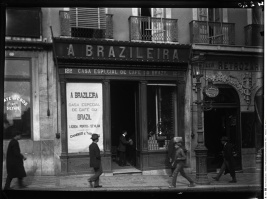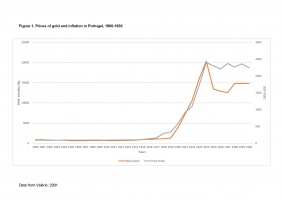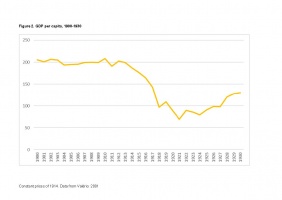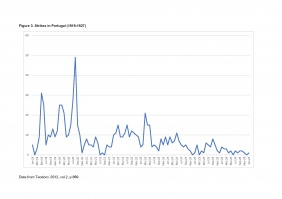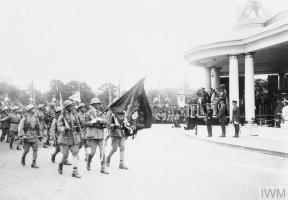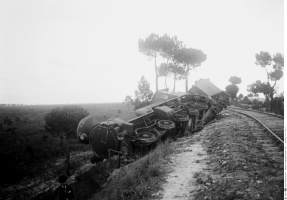Introduction↑
In the aftermath of the war, daily life in Portugal was dominated by high inflation, declining wages, pensions and rents, political and social unrest, industrial growth, and social modernization.[1] At the end of the 19th century, the nation had undergone a “sanitary revolution” and high rates of mortality had begun to decrease, however this trend was counteracted by the war and the pandemic of 1918-1919.[2] Urban growth was centred in Lisbon and Oporto but also affected small towns such as Setúbal, Barreiro, Coimbra and Aveiro. The growth of the modern cotton textile industry and industrial regions in the north was followed by the creation, in the south, of major industrial groups producing food and beverages, as well as chemicals, which were linked to major banks and the daily press.[3] The sector of the population active in industry, transport, and trade grew while that in agriculture and domestic services declined. Wage relations dominated in large capitalist farming states producing cereals, cork, meat, and wine. Export-oriented industries in mining, manufactured cork, and fish-canning stimulated local and regional economies, contributing to their diversification. Development and urbanization increased in the Portuguese colonies Angola and Mozambique under the rule of General Norton de Matos (1867-1955) and High Commissioner Brito Camacho (1862-1934) respectively. Moreover, the new republic, which succeeded the Portuguese monarchy after the republican revolution of 1910, promoted freedom of thought, secular and rational public education, and liberal family values allowing civil marriages and divorce. A prohibition of the public use of nobility titles reinforced the liberal society that republicans intended to shape.
Technical, business, and agricultural schools were reformed under the new regime following advanced European models. Night schools and “mobile free schools” provided education to illiterate workers. A vibrant civil society, often divided by class, thrived during this period, causing commentators to declare a “glorious epoch of free associations” in Portugal.[4] Networks of clubs, such as sports clubs for football and cycling, and civic associations were established in towns and cities across the country. New sensibilities developed after the war, including critiques of bullfighting and ill-treatment of animals and children. The erosion of traditional social relationships and the upswing of class conflict in urban, industrial, and rural areas became a test of the political elites during this period of rapid social change.
After the congress of Covilhã in 1919, labour unions began to reorganize following anarchist principles, uniting urban and rural workers under the umbrella organization Confederação Geral do Trabalho (CGT). The confederation’s news organ, A Batalha, was one of the most read and prestigious daily newspapers in the country. The Communist Party was founded in 1921, creating a long-lasting schism between communists, syndicalists, and anarchists over the political autonomy of the labour unions. For a brief period, the idea of a social republic became a priority among labour militants. At the same time, however, reactionary nationalists, monarchists, and Catholics mobilized, wielding influence in the middle ranks of the army, high schools, and universities.
Despite this modernization trend, general indicators of advancement put Portugal in the lowest rank in Western Europe, and among the poorest countries in all of Europe. By 1920, Portugal had only six million inhabitants, little more than in 1911, due to the war conditions and the Spanish flu. Only 1.7 million were literate, and of these only 700,000 were women. Life expectancy at birth was about forty years for men and 35.8 for women. The child mortality rate increased from 133.9 to 194.1 per 1,000 births in the years after 1914 and fertility rates fell during the same period.[5] Most of the population was located in rural areas, yet the number of people in agriculture declined until the 1930s (about 56 percent in 1920) while the industrial labour force, trade, and services expanded. The urban population was concentrated in Lisbon and Porto, with these cities representing one tenth of the total. Thirty-two percent lived in small towns of five to 20,000 residents. Emigration rates, which had been high since the middle of the 19th century, declined during the war and the early 1920s. Those who did emigrate went to Brazil and the USA, while emigration to the colonies continued to follow established imperial patterns and was primarily undertaken by military personnel, administrative staff, political convicts, traders, and craftsmen, but not unskilled workers. With among the lowest GDPs per capita of European countries in 1920s, Portugal maintained a trend of economic divergence from the most dynamic Western European countries, which had begun in the 1850s at least.[6] Additionally, the Portuguese economy was open to foreigners, who invested mostly in export-oriented business (cork, canned fish, wine, mining, transport, urban services and colonial enterprises). The post-war environment created new business opportunities for nationals, some of whom sought government-awarded licences to open “new industries”, which granted the holder monopoly rights over the implementation of novel industrial process or the local production of goods which had formerly been imported.
The early 1920s was a period of contrasts. While the number of philanthropic institutions and attendants of the charitable “poor kitchen” increased, class tensions ballooned. The number of gambling houses and the rate of luxury consumption soared as a cultural ethos of pleasure-seeking became common among the old bourgeoisie and the nouveau riche.[7] At the same time, from 1919 to 1921, 538 children were abandoned in Lisbon and 162 mothers were taken under the custody of the Santa Casa da Misericórdia de Lisboa (Lisbon Holy House of Mercy)[8] Some economic sectors saw new investments, and others, including textiles, mining, wine, and cork, resumed production, benefiting from high inflation and exchange rates, and recovered following the war. The fishing and canning industries, milling and others now faced overcapacity, overproduction, and what producers saw as excessive state regulation, as was particularly the case with cereals. As new modernist values relating to education, family, and lifestyle, and criticisms of the foundations of bourgeois society spread, reactionaries mobilized the masses around the church and the army.
Inflation↑
Portugal had abandoned the gold standard after the financial crisis of 1891, but the pound sterling remained a reference for the escudo until the war. In the post-war period, the government began to print money to face its immediate responsibilities following the war, having no will or means to take out new loans abroad or to increase taxation (see the image “Prices of gold and inflation in Portugal, 1900-1930”). The shrinking of Portugal’s GDP per capita, which had begun in the years leading up to the war, did not reverse before 1922 (see the image “GDP per capita, 1900-1930”). The upper and middle classes in particular were deeply punished by the inflationary spiral during the 1920s. In 1922, while organized skilled and semiskilled workers often managed to increase their wages, professionals and public officers lost sometimes more than 40 percent of their purchasing power in comparison to 1914 (Table 1). For most people hunger became a daily experience that could only be mitigated through the aid of soup kitchens or charity. The labouring classes had to struggle for survival.
One major consequence of the increasing cost of living was the rising number of strikes in urban and small industrial centres and in the regions dominated by capitalist farming, such as Alentejo and Ribatejo. Many professionals and clerks working in public institutions went on strike alongside other workers, creating a feeling of instability among the middle and upper classes.
Following the crisis of 1923/1924, the government decided to stop monetizing debt. The result was deflation, increasing unemployment, and an economic slowdown.
| Ministry staff | 1914 | 1922 | Var. (%) | 1929 | Var. (%) |
| General director | 5$30 | 1$43 | -73.0 | 2$57 | -51.5 |
| Head of the office | 3$30 | 1$30 | -60.6 | 1$94 | -41.2 |
| State clerk, high rank | 2$47 | 1$15 | -53 | 1$36 | -44.9 |
| State clerk, middle rank | 1$98 | 1$10 | -44.4 | $96 | -51.5 |
| State clerk, lower rank | 1$50 | 1$03 | -31.3 | $82 | -45.3 |
| Vigilant | 1$17 | $63 | -46.2 | $70 | -40.1 |
| General labourer | $83 | $63 | -24.1 | $66 | -20.4 |
| Other professions | |||||
| General (army) | 6$10 | 1$46 | -76.1 | 5$60 | -8.2 |
| Captain | 2$52 | 1$00 | -60.3 | 2$28 | -9.5 |
| Judge, high rank | 2$54 | 1$66 | -34.6 | 2$64 | 3.9 |
| Engineer, high rank | 3$54 | 1$30 | -63.2 | 2$44 | -31.1 |
| Engineer, low rank | $99 | $91 | -8.1 | 1$32 | 33.3 |
| Lecturer (university) | 2$00 | 1$30 | -35.0 | 2$45 | 22.5 |
| Teacher (high school) | 1$49 | 1$08 | -27.5 | 1$84 | 23.5 |
| Teacher (state primary school) | 1$18 | $95 | -19.5 | 1$46 | 23.7 |
| Teacher (general) | $48 | $76 | 58 | $84 | 75.0 |
Table 1: Daily Wages of Professionals, Army, and Public Officers in Portugal, 1914-1929[9]
Strikes↑
From 1909 to 1920, there were 3,086 labour strikes in two major waves (1911 to 1913, and 1916 to 1920). In 1917, at least 256 strikes mobilized nearly three hundred thousand workers across the country. Until 1921, the number of workers in labour conflicts remained high. But after 1924 the number of strikes diminished steadily due to economic depression and harsh repression. Better wages were the most frequent motivation for strikers, but they also demanded better working conditions and the reduction of working hours to an eight-hour day with remunerated weakly rest. Although most of the strikes were concentrated in Lisbon and Oporto, the movement affected almost the entire country and incited further labour occupations. It was not only metalworkers, cork factory workers making cork wine stoppers, glassworkers, shoe and cloth makers, canned fish welders, printers, typists, and goldsmiths working in small or medium-size factories who went on strike, but also unskilled workers, seamen, fishermen, rural laborers, and workers in large organizations, such as railway workers, chemical plant workers, dockworkers, urban transport workers, and miners. Women working in the fish factories and domestic service also unionized, sometimes denouncing practices of sexual harassment by their bosses. Some of these unionized skilled workers faced technological unemployment as a result of mechanization or adverse policies from the government, as was the case for fish can welders, cork factory workers, and construction workers.
Solidarity strikes united rural and urban workers. Strikers’ strategies were diverse: often workers in one factory tried to break the resistance of the factory owner with the support of other local workers. If they were successful in their negotiations, other industrialists were likely to follow the same agreement in order to avoid unrest in their own factories. Local economies or industrial districts across the country, in Marinha Grande, Covilhã, Barreiro, Setúbal, Olhão, and others, favoured local or regional solidarity strikes among workers in the same occupation or trade. The solidarity strikes were critical political issues of the day and discussed at the highest levels of the new republican government.
The strike wave beginning at the end of war was a major threat to republicans and other conservative forces. The participation of telegraph and postal service workers, clerks, civil servants, and other white-collar workers in strikes fuelled fears of social revolution.[10] Until 1924, there were strikes aimed at forcing employers to obey recently enacted, but underenforced, labour legislation. The struggle against landlords and for healthy and better housing became part of the political program of the socialists in the government. The urban struggle against the rise of the price of bread continued, and the end of bread subsidisation by the government in 1922 was followed by a general strike and anti-labour repression.[11]
Strikes were not the only strategy workers employed to further their demands. Sabotage, direct action, arson, riots, bombings, and boycotts all increased the social and economic costs for both sides. The introduction of welding machines in fish factories in Setúbal, for instance, led to workers invading the plants and breaking machines. Likewise, miners flooded mining galleries in response to the militarization of the mining fields by mine owners, who called in the national army to maintain public order. In agricultural contexts, the burning of crop fields was a strategy sometimes associated with labour conflicts, and about fifty arsonists were apprehended by the authorities between 1917 and 1921. Bombings in strike areas were utilized to intimidate the authorities and bosses and became an effective practice among labour militants. In 1923, activists bombed multiple bakeries in an attempt to force their owners not to speculate on the price of bread. The response of the republican government to labour militancy was usually harsh: the militarization of public spaces, deportation of the leaders, and imprisonment, beatings and in some cases execution of strikers were all tactics used to suppress the insurgencies. Employer resistance grew as the strikers became more organized and cultivated the solidarity of the CGT, which represented the unions collectively. The arbitrary shooting of cork workers and children in Silves by the National Republican Guard (GNR) on 2 March 1924, as the workers were receiving the sons of their comrades in Portimão who were on strike, illustrates the ongoing environment of class warfare which presided during this period. In the same period, the government created special tribunals to condemn social militants and their judges were targeted by anarchists. The defeat of two long miners’ strikes in 1923/1924 in Aljustrel and São Pedro da Cova was a landmark in the success of the government’s strategy. Despite the favourable political environment created by the left-wing government of President José Domingues dos Santos (1885-1958), from November 1924 to February 1925, the threat of a fascist dictatorship was already present. Violence against syndicalists, their organizations, and laborers increased the costs of action as conservative economic policies weakened their bargaining power. The two years preceding the 28 May 1926 coup d'état, which ushered in a fascist dictatorship, were defined by low intensity strikes as the labour organizations became embroiled in internal conflicts (see the image “Strikes in Portugal (1919-1927)”).
Labour Unions↑
On 13 September 1919, union delegates to the Second National Labour Congress in Coimbra confirmed the anarchist thesis in the organization. Unions and federation delegates had only a consultative vote and the power remained in the unions, which had a deliberative vote. The unions had formed new local and national organizations under the federalist principles of the CGT, including the Sindicatos Únicos and the Câmaras Sindicais do Trabalho. Through this decision, the power of the workers in assembly was reinforced, and “politicians”, that is, individuals who were not workers but sought election to parliament by appealing to the working classes, were banned. Until 1923, the feeling that social revolution was imminent was shared by many social militants. In 1920 the Labour League for Economic Expropriation was under preparation when the CGT was terminated by the authorities following a general solidarity strike in Lisbon, Porto, Coimbra, and many other towns.
The post-war period was one of intense ideological debate about how future society should be organized, about strategies to overcome the ongoing civilizational crises, and about the “nature of the Russian revolution”. Was the federalist labour organization the embryo that would develop into a libertarian society or was it just a way to prepare society for the future communist (municipal libertarian) society? Was a “proletarian dictatorship” needed? These questions, among others, preoccupied the movement. In particular, the topic of the Internationals (Berlin or Moscow) proved divisive, splitting the movement between the “authoritarian forces” and the libertarians. The CGT affiliated itself with the International Workers’ Association (AIT) in 1922, rejecting the Leninists’ principles of organization, their militant practices, and all kinds of dictatures. Thus, affiliation with the Third International (Comintern) was rejected by the Third National Labour Congress held in Covilhã in 1922.
Despite this, international solidarity existed. In 1919 the dockers' unions refused to load weapons and hardware onto ships sent to support the anti-revolutionary coalition against the Russian revolution. There were organized donation drives in response to the Russian famine, and in 1922 public protests took place against the French occupation of the Ruhr.
In 1921, the syndicalist youth organization held its first congress. Founded in 1912, they had taken an active role in anti-war propaganda and action. As they became actively persecuted by the police, their role as propaganda activists was superseded by direct action strategies. The organization split when the Communist Party was founded in 1921. In the following year, many of its members were arbitrarily arrested and ill-treated by the police. At the same time, the number of anarchist groups, often embedded in syndicalist militancy, grew. On 18 March 1923, the First Regional Anarchist Conference, with forty-three delegates from several areas of the country, created the Portuguese Anarchist Union (UAP), which remained active until 1927. Later, they participated in the creation of the Anarchist Iberian Federation (FAI).
In 1921, there were 730 trade unions across the country, having unionized almost one hundred thousand workers (Table 2). Other estimates claim that they were about one-third of that number, but these figures underestimate the ability of few thousand syndicalists to mobilize entire communities. Despite their successful organization, the unions’ financial base remained relatively weak. In September of 1925, at the National Labour Congress at Santarém, the number of union delegates reached 144, but the departure under communist leadership of the Arsenal Workers’ Unions and of the Maritime Federation, each representing a large number of union payers, was a major blow to the finances of the CGT. Nevertheless, the CGT remained a major social force that sometimes participated in such “political adventures” as the movement of October 1921, which ended with the arrest and execution of republican leaders Machado dos Santos (1875-1921), António Granjo (1881-1921), and José Carlos da Maia (1877-1921), on the Bloody Night of 19 October 1921.
The cultural project embedded in trade unions' everyday life was crucial for the success of the movement. New pedagogical ideas, new gender and family relationships, rational and scientific perspectives, humanism (anti-racism), individual freedom, moral principles, and cultural practices were promoted. A new cultural environment emerged in theatres and the press, and a new group of active intellectuals, journalists, and writers contributed to the cultural supplement of A Batalha, the CGT daily press, disseminating these values. The “advanced social thinking” promulgated by A Batalha editors included the dissemination of Esperanto, the defence of “free love”, birth control, women’s organizations, and vegetarianism. Under the anarchist influence, unions became workers' clubs, often managing libraries, union schools, cooperatives, and even local theatres.
| Sector | Unions | Union members |
| Mining | 3 | 150 |
| Quarrying | 6 | 1,163 |
| Metallurgy | 32 | 3,260 |
| Ceramics | 4 | 53 |
| Glass | 4 | 614 |
| Chemicals | 13 | 1,220 |
| Foodstuffs | 37 | 3,332 |
| Beverages | 5 | 547 |
| Textiles | 23 | 2,686 |
| Cloth | 26 | 2739 |
| Leather | 6 | 341 |
| Footwear | 29 | 2,253 |
| Construction | 85 | 11,324 |
| Wood and furniture | 48 | 5,116 |
| Printing | 13 | 1,008 |
| Clock workers and artisans | 9 | 247 |
| Tobacco | 7 | 3,458 |
| Electrical | 2 | 31 |
| Ship building | 7 | 851 |
| Cart building | 4 | 238 |
| Land transportation | 24 | 9,669 |
| Shipping (seamen) | 37 | 10,599 |
| Hotels | 8 | 680 |
| Small businesses | 62 | 5,736 |
| Trade (salesmen) | 108 | 14,311 |
| Trade and industrialists | 39 | 3,575 |
| Agriculture | 70 | 10,039 |
| Total | 711 | 95,240 |
Table 2: Trade Unions in Portugal, 1921[12]
War Profits↑
The war and the subsequent years of economic and financial instability created favourable conditions for those who were in the position to speculate on transactional goods and services. While pensioners, landowners, public servants, and professionals saw their income consumed by high inflation, new fortunes suddenly appeared and created scandal. Individuals formerly lacking social status exhibited their new wealth by investing in houses, cars, motorbikes, and other luxury goods. High inflation and the recent pandemic led some to spend their time and money on public festivities and entertainment, exploring business opportunities of dubious morality in the eyes of common people. The first law attempting to limit war profiteering was passed in 1918 under the presidency of Sidónio Pais (1872-1918), but revoked the following month.[13] The discussion was reintroduced into parliament in May 1920 as a matter of urgency by the finance minister, when the external debt grew by 40,000, reaching 500,000 contos by the autumn of the same year due to the combined effect of capital outflow and the rising price of gold.[14] Socialists and left-wing republicans defended progressive and high taxation of war profits and an increase in direct taxation of capital and property. Taking influence from France, Britain, and USA, the discussion of the principles of progressive taxation of personal income and entrepreneurial “excessive profits”, and luxury consumption became tumultuous. The conservatives and liberals considered the average capital gains tax of 12 percent excessive, preferring to increase taxes on individual transactions, abolish bread subsidies and reduce social services and other state expenses. Thus, the idea of taxing war profits became a broader discussion of fiscal reform. In 1925, the government of António Maria da Silva (1872-1950) restored public order and halted the depreciation of the escudo, provoking an economic slowdown. In December of 1926, the newly instated military government of Óscar Carmona (1869-1951) printed more than a hundred thousand contos without significant inflationary pressure in the economy.
Corruption↑
The interlinkage of politics, the management of large firms, and personal enrichment was a long-standing feature of Portuguese liberal society. The law was flawed and mostly concerned with the integrity of public officers and deputies. There was even a bureaucratic police force in place to limit the autonomy of public servants. Republicans began to present an image of personal patriotic commitment to the idea of the republic, efficient bureaucracy, and state administration. But the war contributed to the decisive destruction of that image. On the eve of the December 1917 revolution, people were already tired of the “old republicans”. The republicans’ attempt to control distribution and prices through a special ministry, the Supply and Transport Commission, and public services at local and national levels, were often controversial. Though they created opportunities for suspicious practices and enrichment, they remained in place until 1924. Monopolies (on tobacco, matches, and others) and big business, lobbyist syndicates, and state affairs were scrutinized by the press. Scandals were frequent and denounced in detail, so accusations of “unpatriotic behaviour” mixed with politics. In the last year of the First Republic the counterfeiting scam of Alves dos Reis (1896-1955) and his fraudulent bank Angola e Metrópole, as well as the machinations of the tobacco syndicate, dominated the debate in parliament on political corruption.
The accusations of corruption also affected the labour organization, with elected leaders accused of siphoning union funds for personal use. Politically motivated allegations became a known strategy by the local proselytes of the Red International of Labour Unions to gain power.
In short, accusations of corruption in politics and in daily life, combined with concerns of moral decadence, were exploited by the press and across the political spectrum during the post war period, contributing to the erosion of the liberal republic’s political legitimacy.[15]
Conclusion↑
After the war, the new republic exercised a growing influence over citizens’ everyday lives but faced difficulties financing the misericordias, charitable organizations, and their hospitals, asylums, and schools. The eroding effect of inflation was one cause. But the rise of individualism among the newly wealthy was another.[16] For the many newly impoverished by inflation, poverty became unbearable, not a fact of life but a social injustice that could be overcome by social revolution or political authoritarianism.
Until the establishment of the dictatorship in 1926, the social sector followed a sustained growth trend, mobilizing manpower and financial reserves. In 1921, 668 mutual aid societies provided burial and health pensions, medical and pharmaceutical services. With the social financial sector (including the Montepios and Caixas Económicas, similar to credit unions and pawnbrokers) they became an economic force managed by the government-run Instituto de Seguros Sociais Obrigatórios e Previdência Geral (Compulsory Social Insurances Institute) after 1919 when death and accident insurance became compulsory for employers in some industries. Mutual agricultural credit banks, created in 1911 by republicans to help farmers, became a support for large landowners and tenants. They participated in and often led the 276 farmers' unions across the country. Entrepreneurial associations grew and even tried to participate directly in politics through the União dos Interesses Económicos, a political party created in 1923 to unite the major economic forces.
Private insurance and financial services employed about ten thousand clerks, agents, and managers. There were also 1,665 directors of limited companies. With the new industries and trade, they became the visible face of progressive capitalism and modernity.
In the same period, worker-organized cooperatives (mostly selling consumable goods at lower prices and on credit) grew, often promoted by socialists, professionals or companies in urban and industrial areas.
The growth of state military and police forces was another a major feature of the post-war period in Portugal. The number of soldiers and army officers, including top generals, increased to more than thirty thousand by 1921. The Guarda Nacional Republicana, GNR (Republican National Guard), consisting of nearly fourteen thousand men, became militarized.[17] The police (Polícia de Segurança Pública, PSP) and other specialized corps also increased in number. State arsenals additionally employed about four thousand men. Together these organizations represented a major social and political force and a “silent burden” on the federal budget.
The war economy created overcapacity and imbalances in production. At armistice, there were nearly 300 fish factories and 335 flour mills, but only 25 foundries. The rural landscape was still populated by old windmills, watermills, ox carts, and manual laborers. The country had registered only 2.5 thousand motor vehicles and about eight hundred motorcycles, mostly used by wealthy people. Small towns were inhabited by tavern keepers, shopkeepers, manual laborers, washerwomen, street sellers, and the like. Illiteracy remained high. Public libraries (popular and erudite) were frequented by less than fifty thousand per year. Nonetheless there were forty-one daily newspapers across the country. Post-war Portuguese society was full of contrasts, contradictions, and imbalances. While new ideas and social behaviours emerged, mostly in urban contexts and involving the upper and lower classes and within the domain of the labour movement, the reactionary forces of Catholicism and traditionalism emerged in response. Growing political polarization also reflected the deepening of social inequality and the entrenchment of radically oppositional cultural and economic views for the future of Portugal. War profiteering, inflation, strikes and corruption combined with daily political instability and violence eroded the social basis that supported the republican party and its patriotic idealism, fuelling nationalist conservative opposition to the liberal republic.[18]
Paulo Eduardo Guimarães, Research Center in Political Science - CICP
Section Editor: Filipe Ribeiro de Meneses
Notes
- ↑ For a general view of this societal process since the end of 19th century see Guinote, Paulo: A sociedade. da agitação ao desencanto [The society. From agitation to disenchantment], in: Reis, António (ed.): Portugal Contemporâneo, volume 3, Lisbon 1990, pp. 174-249; Oliveira Marques, A. H.: Nova História de Portugal [The new history of Portugal], Lisbon 1991, pp. 13-239; Vaquinhas, Irene (ed.): História da Vida Privada. A Época contemporânea [History of private life. The contemporary era], volume 3, Lisbon 2011; Fonseca, Helder A. / Guimarães, Paulo E.: Social Mobility in Portugal (1860-1960). Operative Issues and Trends, in: Continuity and Change 24 (2009), pp. 513-546; Fonseca, Helder A. / Guimarães, Paulo E.: Portugal e as Sociedades Europeias. Família, Revoluções Sexuais, Homogamia e Fronteiras de Classe [Portugal and European Societies. Family, sexual revolutions, homogamy and class boundaries], in: Perspectivas - Journal of Political Science 4 (2010), pp. 77-113.
- ↑ Rodrigues, Teresa: História da População Portuguesa [History of the Portuguese Population], Porto 2008, p. 381; Valério, Nuno: Estatísticas Históricas Portuguesas [Portuguese Historical Statistics], Lisbon 2001, pp. 63-64; 67-72.
- ↑ See Rocha, A. Vieira da: Le Portugal au travail, Paris 1921.
- ↑ Lousada, Maria Alexandre: O “espírito de associação” em Portugal. Dinâmica social e legislação (1820-1926) [The “spirit of association” in Portugal. Social dynamics and legislation (1820-1926)] , in: Veloso, Luísa et al. (eds.): Anarquismo, Trabalho e Sociedade [Anarchism, labor and society], Lisbon 2017, p. 117.
- ↑ See Rodrigues: População.
- ↑ Reis, Jaime: Causas Históricas do Atraso Económico Português [Historical causes of the Portuguese economic backwardness], in: Tengarrinha, José (ed.): História de Portugal [History of Portugal], São Paulo 2000, p. 244; Palma, N. / Reis, J.: From Convergence to Divergence. Portuguese Economic Growth, 1527-1850, in: The Journal of Economic History 79/2 (2019), pp. 477-506. See also Maddison Project Database 2020, issued by University of Gronigen, online: https://www.rug.nl/ggdc/historicaldevelopment/maddison/releases/maddison-project-database-2020?lang=en (retrieved: 14 January 2023). Bolt, Jutta / van Zanden, Jan Luiten: Maddison Style Estimates of the Evolution of the World Economy. A New 2020 Update, 2020.
- ↑ França, José Augusto: Os Anos Vinte Em Portugal. Estudo de Factos Sócio-Culturais [The Twenties in Portugal. Study of socio-cultural facts], Lisbon 1992.
- ↑ The Santa Casa da Misericórdia de Lisboa was the first of several charitable Christian institutions (misericordias) created from 1498 in Portugal and its overseas dominions.
- ↑ Estimates of daily wages in Portuguese escudo in 1914, 1922, and 1929 and variation (var.) in percent of income from 1914. Source: Boletim da Previdência Social (BPS), 12, 13, 20, Lisbon, 1923, 1930.
- ↑ See Guimarães, Paulo E.: Anarquismo, violência e protesto popular durante a Primeira República em Portugal [Anarchism, violence and popular protest during the First Republic in Portugal], in: Veloso, Luísa et al. (eds.): Anarquismo, Trabalho e Sociedade [Anarchism, work and society], Lisbon 2017, pp. 51-80. A testimony on the civil servants’ strike: de Brito, Nogueira: Notas e comentários sobre a greve do funcionalismo público em 1920 [Notes and comments on the civil service strike in 1920], Lisbon 1976. A qualitative study of the miners’ strikes of 1922-1924 in the major Portuguese mines: Guimarães, Paulo E.: Indústria e conflito no meio rural. Os mineiros alentejanos (1858-1938) [Industry and conflict in rural areas. The Alentejo miners (1858-1938)], Lisbon 2001.
- ↑ Telo, António José: Primeira República [The First Republic], volume 2, Lisbon 2010.
- ↑ BPS, 1921.
- ↑ Decreto n.º 4841, de 26 de setembro [Decree 4841], in: Diário do Govêrno n.º 210/1918, Série I de 1918-09-26, 26 September 1918, pp. 1731-1732.
- ↑ Anuário Estatístico de Portugal [Statistical Yearbook of Portugal], 1921, Lisboa, 1925, pp. 396.
- ↑ See Engels, Jens I. / Homberg, Marício: Corruption Debates in the First Portuguese Republic 1910-1926, in: Revista Portuguesa de História 3 (2022), pp. 79-96.
- ↑ See Brandão, Raúl: Memórias [Memories], Lisbon 1925-1933.
- ↑ Anuário Estatístico de Portugal [Statistical Yearbook of Portugal], 1921, Lisbon 1925.
- ↑ See the synthesis of the different theses on the origins of the Portuguese dictatorship by Reis, António: Epílogo. O fim da Primeira República [Epilogue. The end of the First Republic], in: Rosas, Fernando / Rollo, M. Fernanda (eds.): História da Primeira República Portuguesa [History of the First Portuguese Republic], Lisbon 2009, pp. 569-580. Following Barrington Moore Jr.’s thesis on the social origins of dictatures, see Medeiros, Fernando: A Sociedade e a Economia Portuguesas nas Origens do Salazarismo [The society and Portuguese economy in the origins of Salazarism], Lisbon 1978; a Gramscian perspective: Schwartzman, Kathleen C.: The Social Origins of Democratic Collapse. The First Portuguese Republic in the Global Economy, Lawrence 1989; Mahoney, James: Knowledge Accumulation in Comparative Historical Research. The Case of Democracy and Authoritarianism, in: Mahoney, James / Rueschemeyer, Dietrich (eds.): Comparative Historical Analysis in the Social Sciences, Cambridge 2003, pp. 131-174. Current historiography focuses on the dynamics of the political competition in the 1920s. See for instance Fernandes, Paulo J.: A crise do liberalismo – 1890-1930 [The crisis of liberalism - 1890-1930], in: Costa Pinto, A. (ed.): História Política Contemporânea - Portugal, 1808-2000 [Contemporary Political History - Portugal, 1808-2000], Lisbon 2019, pp. 139-210; Baiôa, Manuel / Fernandes, Paulo Jorge / Meneses, Filipe Ribeiro de: The Political History of Twentieth-Century Portugal, in: e-JPH 1/2 (2003).
Selected Bibliography
- Amaral, Luciano: Outubro. A revolução republicana em Portugal (1910-1926) (October. The Republican revolution in Portugal (1910-1926)), Lisboa 2011: Edições 70.
- Brandão, Raúl: Memórias (Memories), Lisbon 1925, 1933: Seara Nova.
- Correia, Francisco António: A evolução económica e a crise social (The economic evolution and the social crisis), Lisbon 1927: Instituto Superior de Comércio de Lisboa.
- Fernandes, Paulo J.: A crise do liberalismo – 1890-1930 (The crisis of liberalism - 1890-1930): História Política Contemporânea - Portugal: 1808-2000, Lisbon 2019: Penguin Random House, pp. 139-210.
- Fernandez Clemente, Eloy: Portugal en los años veinte. Los origines del «Estado Novo» (Portugal in the 1920s. The origins of the "Estado Novo"), Valladolid 1996: Universidad de Valladolid.
- Fonseca, Helder A; Guimarães, Paulo E.: Social mobility in Portugal (1860–1960). Operative issues and trends, in: Continuity and Change 24, 2009, pp. 513-546.
- França, José Augusto: Os anos vinte em Portugal. Estudo de factos sócio-culturais (The Twenties in Portugal. Study of socio-cultural facts), Lisbon 1992: Editorial Presença.
- Homberg, Mauricio; Engels, Jens Ivo: Corruption debates in the First Portuguese Republic 1910-1926, in: Revista Portuguesa de História 53, 2022, pp. 79-96.
- Rocha, A. Vieira: Portugal au travail, Paris 1921: P. Roger.
- Rosas, Fernando / Rollo, Maria Fernanda (eds.): História da primeira República Portuguesa (History of the Portuguese First Republic), Lisbon 2009: Ediçoes Tinta da China.
- Teixeira, Nuno S. / Pinto, António C. / Monteiro, Nuno G. (eds.): História contemporânea de Portugal. 1808 - 2010 (Contemporary history of Portugal. 1808-2000), volume A crise do liberalismo 1890 - 1930, Lisbon / Madrid 2013: MAPFRE.
- Telo, António José: Primeira República I. Do Sonho à Realidade (The First Republic I. From dreams to reality), Lisbon 2010: Presença.
- Teodoro, José M.: A confederação geral do trabalho (1919-1927) (The General Confederation of Labor (1919-1927)) (in Portuguese): A confederação geral do trabalho (1919-1927) (The General Confederation of Labor (1919-1927)), Lisbon 2013.
- Valério, Nuno (ed.): Estatísticas históricas portuguesas (Portuguese Historical Statistics), Lisbon 2001: Instituto Nacional de Estatística.
- Vieira, Alexandre: Para a história do sindicalismo em Portugal (For the history of syndicalism in Portugal), Lisbon 1974: Seara Nova.





